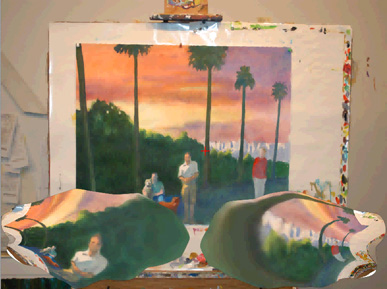Do You See What I See? A Conversation with MD-PhD Jonathan Horton
Have you ever wondered what the world really looked like?
This might seem a silly question at first. But consider this. Colors, shapes, faces — you name it — pass through a series of relay stations in the brain, beginning with the retina. At each station, the visual information is processed, creating an image that we ultimately and instantaneously interpret as sight. Yet is what we're seeing full and complete, or a shorthand version? And to dabble for a moment in science fiction, are we all seeing the same things?

Jonathan Horton
"Sight is perception," says Jonathan Horton, MD, PhD, a former history-major-turned-scientist who now heads UCSF's Laboratory for Visual Neuroscience. "It's a process where information is extracted, transformed and distilled. That's where I come in," he adds. "I try to understand how visual information is represented at each stage — how it is coded and then passed on."
But can we reverse the process, I wonder, and in doing so, reconstruct reality? "Our understanding of what the visual system is doing is too incomplete to get a coherent view of what the real stimulus is," Horton concedes. Or maybe the concept is just too disruptive or too esoteric for science to either tackle or test.
Horton thinks not. "We're in the very early stages, but eventually we will have a complete enough description of the visual system to know what operation is being carried out at each level. And then we will be in a position to infer exactly how the visual system enables us to see."
It's been a long haul. The visual system has been one of the most studied brain systems in science; Johannes Kepler first explained the optics of the eye in 1604. Even today, probably hundreds, if not thousands, of researchers study some aspect of sight, either directly to help patients or as a model for how the brain works.
Horton does both. The 50-year-old San Mateo, California, resident and father of three spent 14 years acquiring the research and clinical skills that have made him an expert in understanding the visual cortex and in treating strabismus and amblyopia, commonly referred to as crossed eyes and lazy eye.
"These conditions create a lot of disability and difficulty for children and adults," he explains. "And it turns out that both are diseases of the central visual system, diseases of what we call binocular integration (or how two eyes yield a single, seamless image)."

Follow the red cross, which patterns how we scan an image for content, and watch as these scans are stitched together and projected in the brain's visual cortex.
Horton sees patients one day every week, and whether he confronts unexplained vision loss or ophthalmic nerve disorders, he attacks the problems with the same curiosity that first enticed him into the field of vision as an admittedly awestruck medical student. "Sometimes I just don't know what's wrong and I can't offer much help. But then there are times when I can actually treat and solve a problem, and that is very satisfying."
Still, there remains the underlying mystery of how we see, a mystery that exerts as powerful an attraction on him as those mountain peaks in California and the Andes that he so loves to hike and climb.
"I picked history as an undergraduate major because I wanted to understand how people work. You can do that by studying the human condition and looking at the historical record. As a scientist, you can also do that by cutting up brains and studying them under the microscope."
This is not some ghoulish game Horton is playing. There is something very fundamental at work here: a discovery process that has already forced him to rethink what vision is.

Torsten Wittmann
"If you look at how dogs, cats, monkeys and humans see, you find the same basic process," Horton explains. "Yet there are surprising differences inside their brains."
In many mammals, for example, cells that share the same visual receptors are organized into columns. When you see enough of these so-called ocular dominance columns, which are particularly well-organized in humans, you begin to assume that they are standard structures, essential for sight. Guess again. "In squirrel monkeys," says Horton, "some have columns and some don't. And the variations can be almost whimsical. Yet the monkeys can all see."
So what does this mean? Horton remains typically low-key, even as he describes how his "negative discovery" has shaken orthodox views. "Perhaps the columns are the brain equivalent of spandrels." Spandrels? Those roughly rectangular-shaped corners created when the curve of an arch meets the ceiling? "A spandrel is what you get when you make an arch," he says. "The same kind of thing could be happening in the brain."
Which would mean that we really don't know why these columns exist at all? "Yes," says Horton. "This was a serendipitous discovery, but it shows that we're still at an early stage in understanding the brain and the structures within it."
It also opens the door to an extraordinary possibility. Horton maps the visual cortex, so he is loath to generalize. Still, as a former historian who once studied the work of medieval scientist Thomas Bradwardine, a pre-Newtonian who turned out to be only "half-right" about the mechanics of the universe, Horton appreciates that research questions have intrinsic value because they stimulate thought.
"Any child of the 1960s was taught that all brains are equal — that we all start out with the same intelligence; that our brains are a tabula rasa and that whatever the environment loads in is what influences us. It might be politically incorrect now to extrapolate from what we have learned about other mammals into human potentialities, but I think this old philosophy is on the wane.
"There might be quite a bit of structural difference from person to person. It would be very dicey to tease them out and very difficult to substantiate without bias, but we could one day find that there is a rich variation in brain organization among humans."
When you think about that for a moment, certain assumptions begin to fade like winter shadows at the North Pole. Maybe the next frontier is out there, just beyond our fingertips. Maybe there is a whole new visual language to learn. Maybe, well, seeing is not believing, at least in the way we think it is. And maybe it's time to open our eyes to new possibilities — and to appreciate anew how science can invigorate reason and lead us all to the mountaintop.
Photos/Ilona Garner
Alternative content
Related Links
- UCSF Laboratory for Visual Neuroscience
- UCSF Department of Ophthalmology
- Complete flatmounting of the macaque cerebral cortex
- Visual Neuroscience, November 2003
- Capricious expression of cortical columns in the primate brain
- Nature Neuroscience, January 21, 2003
- Independent Projection Streams from Macaque Striate Cortex to the Second Visual Area and Middle Temporal Area
- The Journal of Neuroscience, July 2, 2003
- Intrinsic Variability of Ocular Dominance Column Periodicity in Normal Macaque Monkeys
- The Journal of Neuroscience, November 15, 1996
- Anatomical Demonstration of Ocular Dominance Columns in Striate Cortex of the Squirrel Monkey
- The Journal of Neuroscience, September 1, 1996
- Visual cortex
- Wikipedia
- Visual cognition and cognitive science website
- Michigan State University
- Vision science demonstrations
- NASA Vision Group
- NASA Ames Research Center